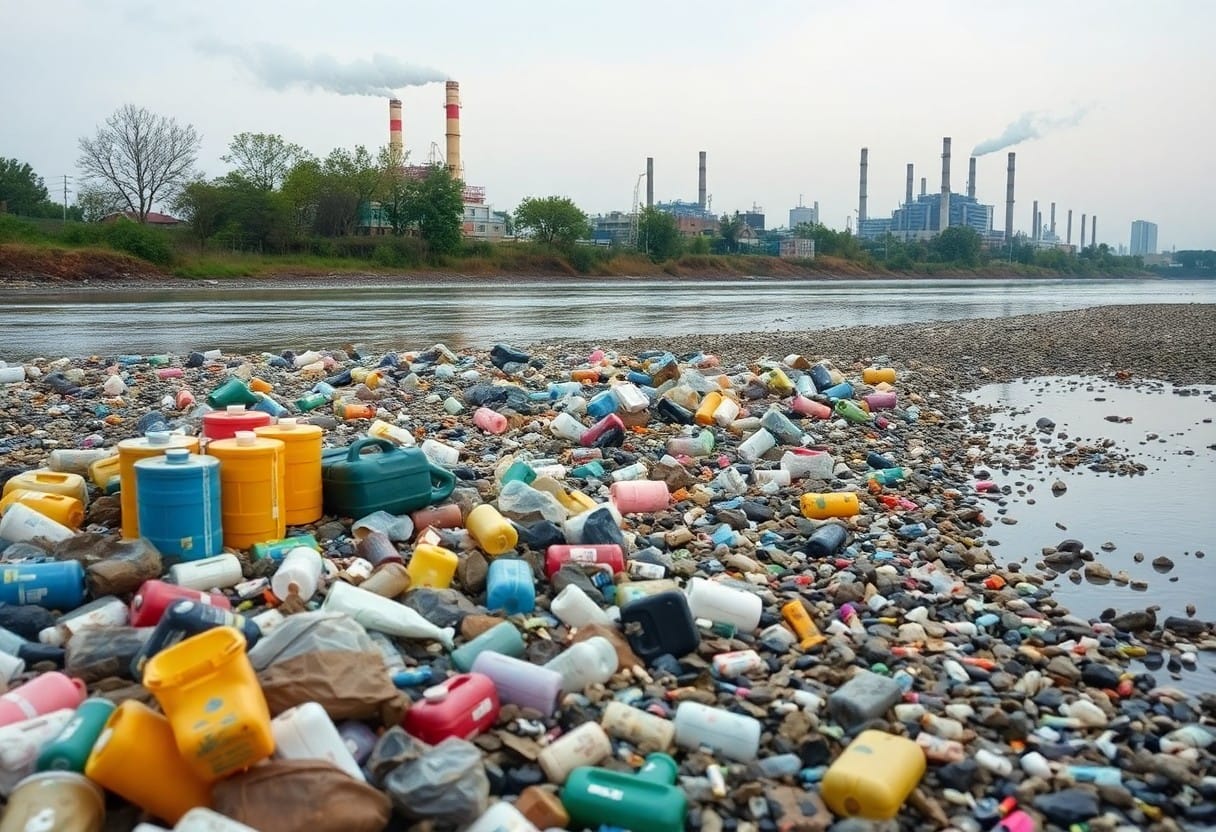Most people are unaware that PFAS (per- and polyfluoroalkyl substances) can enter your food supply through various pathways, posing potential health risks. From the use of non-stick cookware to contaminated water sources, these chemicals can accumulate in your food and ultimately end up on your plate. Understanding how PFAS infiltrates your meals is vital for making informed choices about your diet and ensuring your family’s safety. In this blog post, we’ll explore the different ways these substances can appear in your food and what you can do to minimize exposure.
What Are PFAS?
Before delving into their impact, it’s important to understand what PFAS are. These synthetic chemicals, known as per- and polyfluoroalkyl substances, have been used for decades in various applications. Due to their water- and grease-repellent properties, they are commonly found in products such as non-stick cookware, food packaging, and water-repellent clothing. Their widespread use has raised significant concerns about their persistence in the environment and potential health implications.
Definition and Characteristics
What makes PFAS particularly concerning is their global prevalence and persistence in both the environment and human bodies. Characterized by strong carbon-fluorine bonds, these chemicals do not break down easily, leading to their accumulation over time. This unique property contributes to their classification as “forever chemicals,” posing long-term risks to human health and ecosystems.
Common Sources of PFAS
To understand the threat PFAS pose, you should know common sources in your everyday life. They are prevalent in various consumer products such as waterproof clothing, food wrappers, and cleaning agents. Additionally, industrial facilities and even municipal wastewater treatment can release PFAS into the environment.
Definition of PFAS sources encompasses both industrial activities and consumer products. You may unknowingly expose yourself to PFAS through food packaging, such as microwave popcorn bags or fast food wrappers, which often contain these chemicals. Additionally, products like stain-resistant carpets or even some cosmetics contribute to this exposure. As these substances enter the environment, they can contaminate soil and water, putting you at risk through contaminated food supplies and drinking water.

Pathways of PFAS Entry into Food Supply
If you are concerned about the presence of PFAS in your food supply, understanding how these chemicals find their way into the system is imperative. Various pathways exist, including water sources, soil interactions, and even food packaging, all of which can contribute to the accumulation of these harmful substances in crops and livestock. Awareness of these pathways can empower you to make informed decisions about your food choices and seek safer options.
Water Contamination
Water contamination is a significant pathway through which PFAS enter the food supply. When drinking water is tainted with PFAS, agricultural irrigation can also spread these chemicals to crops. As you consume vegetables or grains grown in contaminated water, PFAS levels can accumulate in your diet, raising potential health risks.
Soil and Crop Interactions
Food grown in contaminated soil can absorb PFAS, posing a risk to your health. As these chemicals leach from landfills or industrial sites into the soil, they can infiltrate crops through root uptake, which may lead to the presence of PFAS in the produce you consume.
Consequently, the relationship between soil and crops can significantly affect your exposure to PFAS. Research indicates that as crops take up contaminated soil, they can accumulate high levels of PFAS, particularly in leafy greens and root vegetables. Moreover, the impact of PFAS extends beyond health concerns, potentially affecting yield and quality of food crops, which may raise concerns about food security. By understanding these dynamics, you can advocate for cleaner agricultural practices and make safer choices in your diet.
Industries Contributing to PFAS Contamination
Assuming you understand the pervasive nature of PFAS, it’s vital to recognize that various industries significantly contribute to this contamination. The manufacturing and agriculture sectors are among the primary culprits, using PFAS in products like firefighting foam, packaging, and even certain pesticides. These industries can release these chemicals into the environment, increasing the risk of PFAS entering your food supply through soil and water sources.
Manufacturing Processes
After examining the manufacturing processes, you’ll find that many industrial activities utilize PFAS for their properties, including water and grease resistance. Common examples include the production of nonstick cookware, stain-resistant textiles, and food packaging materials. These processes often lead to unintended discharge of these harmful chemicals into the environment, contributing directly to the contamination of water systems and, ultimately, your food.
Agricultural Practices
After understanding the role of agriculture, it’s vital to note that PFAS contamination can also stem from the use of contaminated water for irrigation and application of biosolids, which may contain PFAS from industrial waste. This practice introduces these harmful substances into the soil, where they can be taken up by crops, greatly impacting your food supply.
Further, you should be aware that the usage of recycled waste products in agriculture can pose a significant risk. These materials often contain residues of PFAS, which can migrate into crops grown in contaminated soil. As a result, root vegetables and leafy greens are particularly at risk, with health implications stemming from long-term exposure. By understanding the agricultural practices linked to PFAS, you can make informed choices about your food and advocate for safer practices in the industry.
Effects of PFAS on Food Safety
All consumers should be aware that the presence of PFAS in the food supply raises significant safety concerns. These substances can accumulate in your body over time and may lead to various health problems. Understanding these risks is crucial for making informed choices about the food you consume.
Health Risks to Consumers
Health risks associated with PFAS exposure include immune system disruption, potential development of certain cancers, liver damage, and thyroid issues. These substances can also impact your cholesterol levels, creating further health complications. It’s crucial to be aware of these risks, especially as PFAS can persist in your body for extended periods.
Impact on Food Quality
Around the food you eat, the impact of PFAS can be significant, affecting not only safety but also overall quality. Studies indicate that PFAS can lead to altered taste and nutritional deficits in contaminated food items. As a result, these substances can compromise the food’s intended flavor profile and nutritional benefits, which could impact your meals over time.
Also, food contaminated with PFAS might experience degradation of its natural flavors and a reduction in healthy properties, potentially leading to suboptimal food choices for your diet. Increased levels of PFAS can create undesirable tastes and reduce the nutritional value of fruits, vegetables, and animal products. Understanding how these substances influence food quality can empower you to make better dietary choices that prioritize both safety and nutrition.
Regulatory Measures and Standards
To effectively address the growing concerns surrounding PFAS contamination, regulatory measures and standards are being developed to protect public health. Various government agencies are working to establish guidelines that regulate the presence of PFAS in food, water, and the environment, promoting safer practices across industries. These measures aim to minimize exposure to these harmful chemicals, ensuring the safety and quality of your food supply.
Current Regulations on PFAS
Any regulations on PFAS are still evolving, with some states implementing their own stringent limits on these chemicals, while federal standards are in the works. Currently, the Environmental Protection Agency (EPA) has issued health advisories for certain PFAS compounds, guiding you and your communities on safe levels. However, a comprehensive federal regulation that explicitly limits PFAS in food is yet to be fully established.
Efforts for Improvement and Monitoring
Improvement of PFAS regulations is crucial for addressing this widespread contamination. Increased monitoring efforts are being implemented to ensure that safe levels of these substances are maintained in food products. Government agencies and environmental organizations are collaborating to assess and reduce PFAS levels, advocating for better testing methods and risk assessments. This coordinated approach not only aims to identify and eliminate PFAS sources but also to ensure that you can trust the safety of your food supply. Enhanced public awareness, combined with improved regulations, is key to safeguarding your health from exposure to these persistent and harmful chemicals.
Reducing PFAS Exposure in the Food Supply
Despite the challenges posed by PFAS contamination, there are effective strategies to reduce exposure in the food supply. Implementing comprehensive testing and stricter regulations for water and soil can help mitigate risks. Additionally, supporting local and organic farming operations can ensure that your food comes from sources less likely to be contaminated. Being proactive in food sourcing and advocating for transparency from food producers can significantly lower your family’s exposure to these harmful chemicals.
Best Practices for Farmers
Any farmer looking to minimize PFAS contamination should prioritize soil testing and monitoring water sources, especially if they are near industrial sites. Employing sustainable practices, such as using organic fertilizers and implementing crop rotation, can also help reduce the risk of PFAS buildup in your crops. Regular education on handling and disposing of materials that might contain PFAS is equally important. By adopting these practices, you can safeguard not only your produce but also contribute to a healthier food supply.
Consumer Awareness and Actions
Around the country, consumers are becoming increasingly aware of PFAS and its potential impact on health. By educating yourself about the sources of PFAS and changing your purchasing habits, you can significantly reduce your exposure. Engage with local farmers at farmers’ markets and prioritize purchasing from sources that adhere to sustainable practices. Additionally, advocating for stronger regulations and transparency in food production can amplify your impact as a consumer.
Reducing your exposure to PFAS requires proactive measures and an informed approach. Regularly check local news for updates on water quality and food safety. Consider using apps or websites that provide information about PFAS levels in food products. When shopping, look for certifications that indicate cleaner farming practices and minimize processed foods that may be sourced from contaminated areas. Your actions, from how you shop to whom you support, can create positive change in the food system and contribute to the end of PFAS contamination.
Final Words
Conclusively, understanding how PFAS enters our food supply empowers you to make informed choices about what you consume. From contaminated water sources to agricultural practices, recognizing these pathways helps you protect your health and advocate for safer policies. Stay vigilant about the foods you choose and consider sourcing from local, organic producers to minimize your exposure. By being proactive, you contribute to a growing awareness of PFAS risks and help drive demand for safer alternatives in the food industry.





















